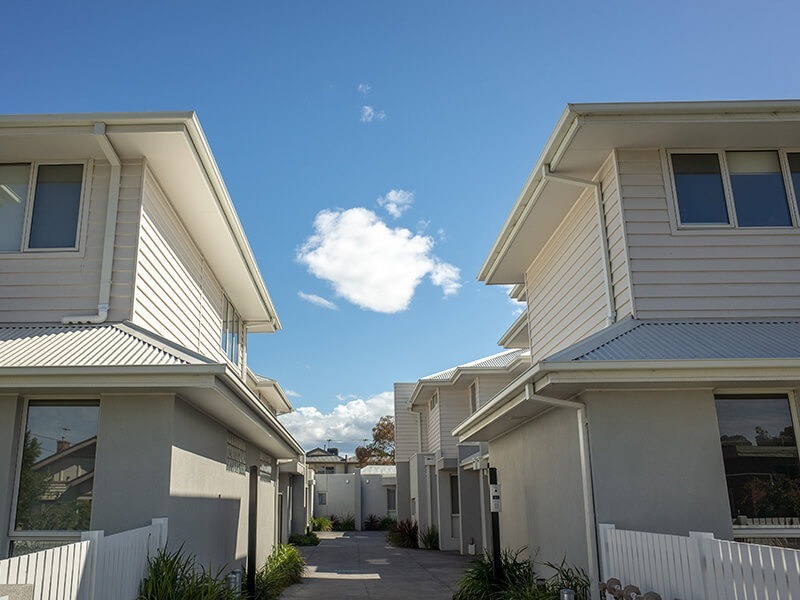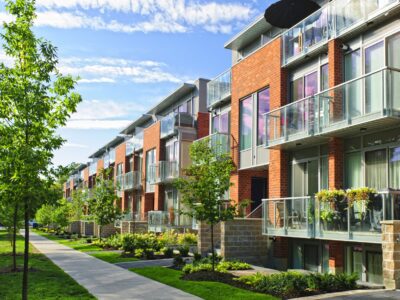Common property is a sometimes confusing and complex part of life in a body corporate scheme. Read on to discover all you need to know about common property.
The definition of common property
Common property is defined as all the areas of the strata building and land that are not included in any individual owner’s lot. The common property areas are jointly owned by all the owners, and the body corporate is responsible for the management and upkeep of the common property.
For example, imagine a high-rise complex of units. Each owner owns their own lot (or unit) but they access that lot through grounds, walkways, doors, stairways and foyers that are commonly used by everyone. Common property is shared by everyone and does not form part of any lot.
What common property generally includes
- Gardens, lawns and grounds
- Stairways
- Lifts or ramps
- Foyers
- Basement or other car parking areas
- Access roadways
- Roofs
- Joint walls, including doors, windows or other structures within the wall
- Infrastructure such as water, power and sewerage
- Floors
- Tiles attached to common property surfaces
- Pipes and electrical wiring located in common property or servicing more than one lot
- Balcony walls and doors
- Facilities on common property such as BBQs and pools
- The foundations and outside of the building
- Railings or balustrades which lie on or near the boundary between a lot and common property
Because each strata scheme is individual and unique, the common property of each scheme will also be individual.
Care and maintenance of the common property
The common property of a strata scheme is cared for and maintained by the group of owners as a whole. This includes repairing problems and defects, as well as replacing and renewing common property when needed. The body corporate is required by law to undertake maintenance to those parts of the scheme for which it is responsible.
In order to pay for the care and maintenance of the common property, the body corporate collects regular levy payments from each lot owner in a scheme. The amount of these payments is determined by the body corporate and reflects the approved budget for the scheme, as resolved at the body corporate annual general meeting.
Common property boundaries
Where the common property boundaries lie will depend on which plan your building falls under. In Queensland, there are two types of strata schemes:
- Standard Format Plan – a common type of plan for use with gated communities or townhouses
- Building Format Plan – all vertical developments, no matter how many levels they contain, are classed under the Building Format Plan
Under the Building Format Plan, boundaries between common property and lots are measured from the centre of the floors, walls, ceilings and doors. Take for example, the wall between your unit and your neighbour – the inside wall is considered within your lot and the same goes for your neighbour but the infrastructure between the two walls will be common property.
For example: if a problem occurred on the roof of one unit in a complex, it would be a body corporate matter to resolve. If, on the other hand, a problem developed on the ceiling of the same unit, it would be the individual owner’s responsibility to resolve.
In contrast to this, Standard Format Plan boundaries are measured from pegs in the ground, the same way as a regular house lot would be measured.
For example: if a problem occurred on the roof or the ceiling of one unit in a complex, it would be the responsibility of that lot owner to resolve, as the whole unit falls within the boundaries of the lot. An exception occurs with something is shared with more than one lot, like television antennas, guttering. If a problem occurred in the guttering of one unit that is shared within another unit, it would be a body corporate matter to resolve, as the guttering is now a shared service.
Plumbing and electrical cabling even though within the lot may be body corporate if that particular pipe/cable services more than one lot. Infrastructure servicing the one lot will be the owner responsibility.
Who is responsible for dealing with common property issues?
That depends very much on where the source of the problem is located, as well as the nature of the problem. Determining responsibility for maintenance can be tricky in many situations that are not clear-cut. Here are some guidelines:
- If the source of the problem is located within a lot boundary, with few exceptions the lot owner is responsible for maintenance.
- If the source of the problem is located inside the boundary structure of a lot (such as a wall between a unit and common property, or a wall between units), the body corporate is usually responsible (although there are a few specific exceptions to this rule). These types of issues generally require the assistance of a contractor to aid in determining the exact cause and therefore assisting as to whom is responsible.
- If the source of the problem is located in a courtyard (involving such items as water tanks, hedges, landscaping etc.), the lot owner is usually responsible for maintenance. If the problem involves fencing, the body corporate and/or the neighbours is usually partly responsible.
- If the source of the problem is in a common property area (such as the roof, a hallway or parking area), the body corporate is responsible for maintenance to the structure (for example, flooring, walls, light fittings, handrails etc.). The responsibility to repair utility/service infrastructure located on common property depends on who benefits from that infrastructure.
- If more than one lot is affected by the problem (such as an issue with communal electricity services, sewerage or hot water systems), the body corporate is usually responsible for repair and maintenance.
Of course, it’s always best to seek guidance from your body corporate manager in situations where the line between common property and individual property is a little hazy. Contact Capitol here for advice: https://www.capitolbca.com.au/contact-us/
By-laws relating to common property
Due to the communal nature of living in a strata scheme, owners are limited as to what they can do and how they use the common property. There are many by-laws relating to the use of common property. These include by-laws relating to:
- Noise
- Pets
- Children
- The appearance of units
- Behaviour
- Damaging, obstructing or littering common property
- Clothes drying
- Vehicles and parking
- Storage of dangerous goods
- Garbage disposal
These by-laws can vary significantly from scheme to scheme, so it’s always best to check the specific by-laws that apply to your scheme.
How can owners make alterations to common property?
Individual owners will need to obtain permission from the body corporate before altering or removing any part of the common property. Renovations or repairs to an individual lot that involve common property (including structural elements within the lot) will similarly need permission from the body corporate. This permission can be granted at a general meeting of the body corporate.






 Community Spirit
Community Spirit